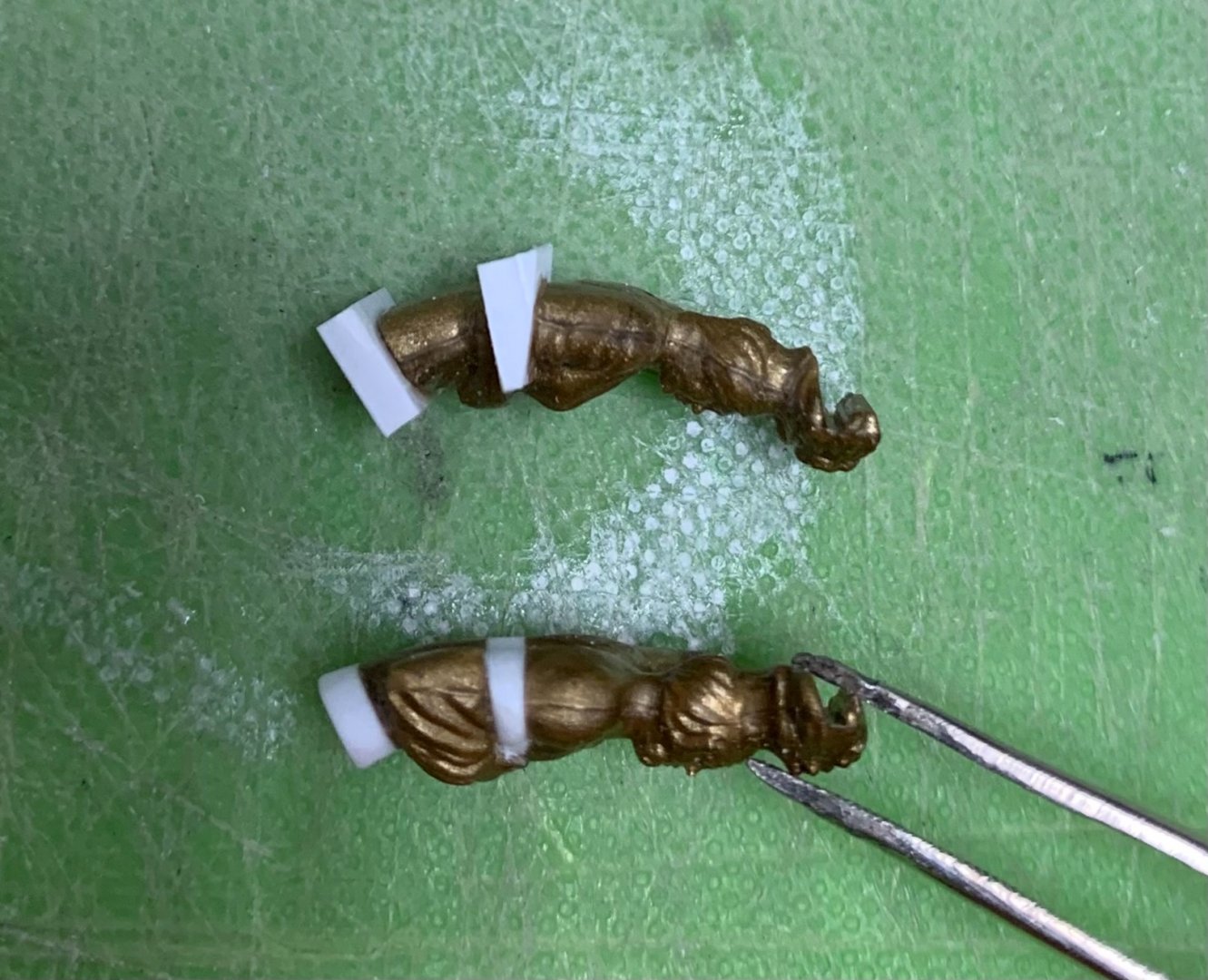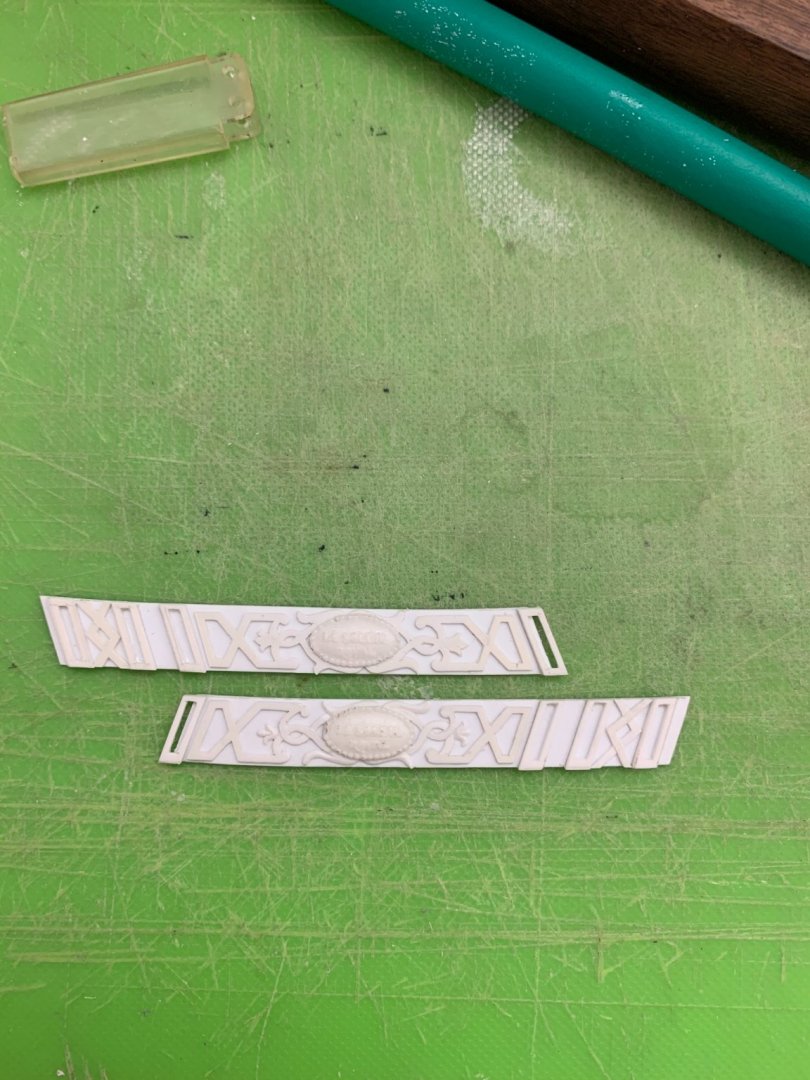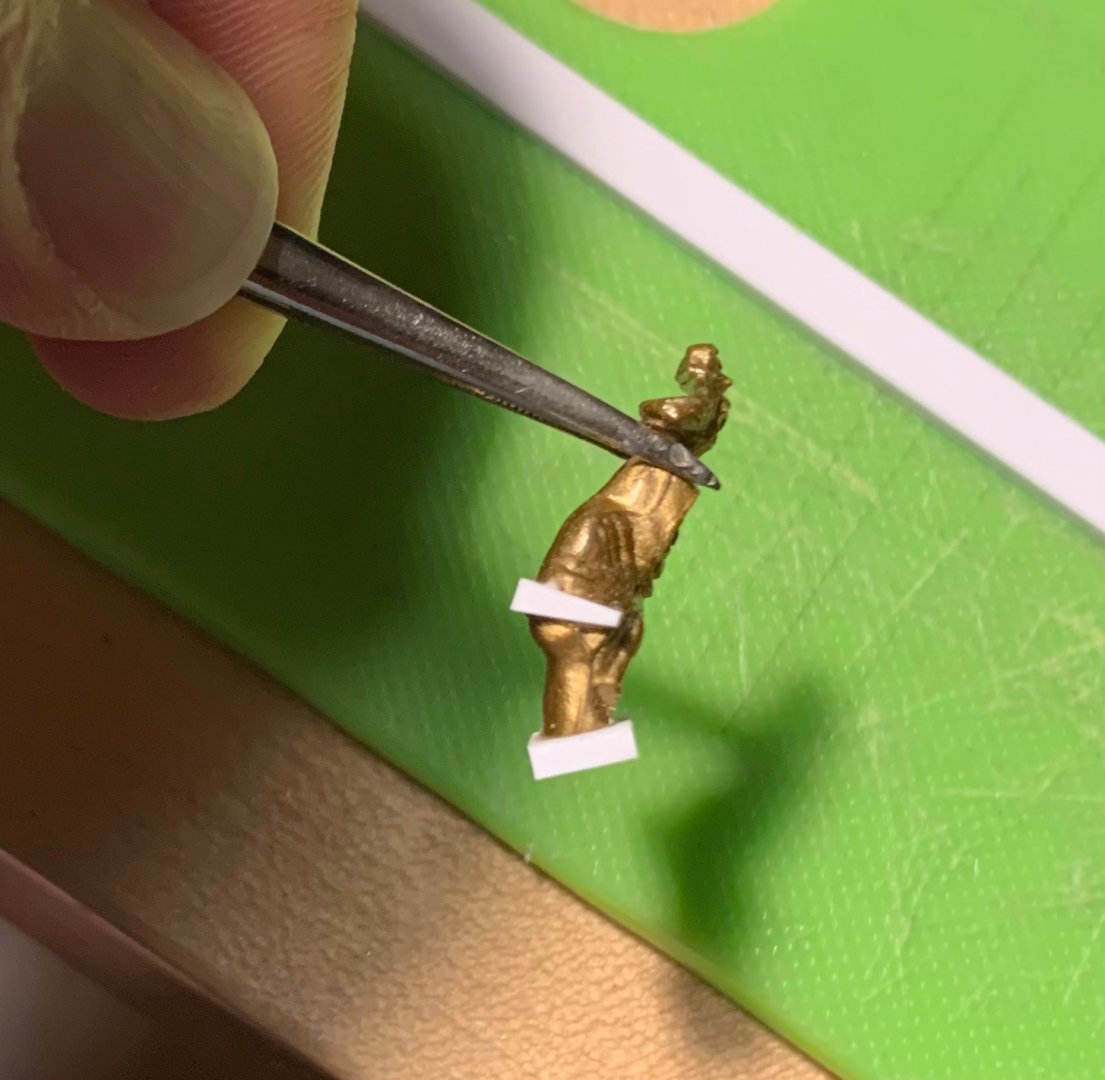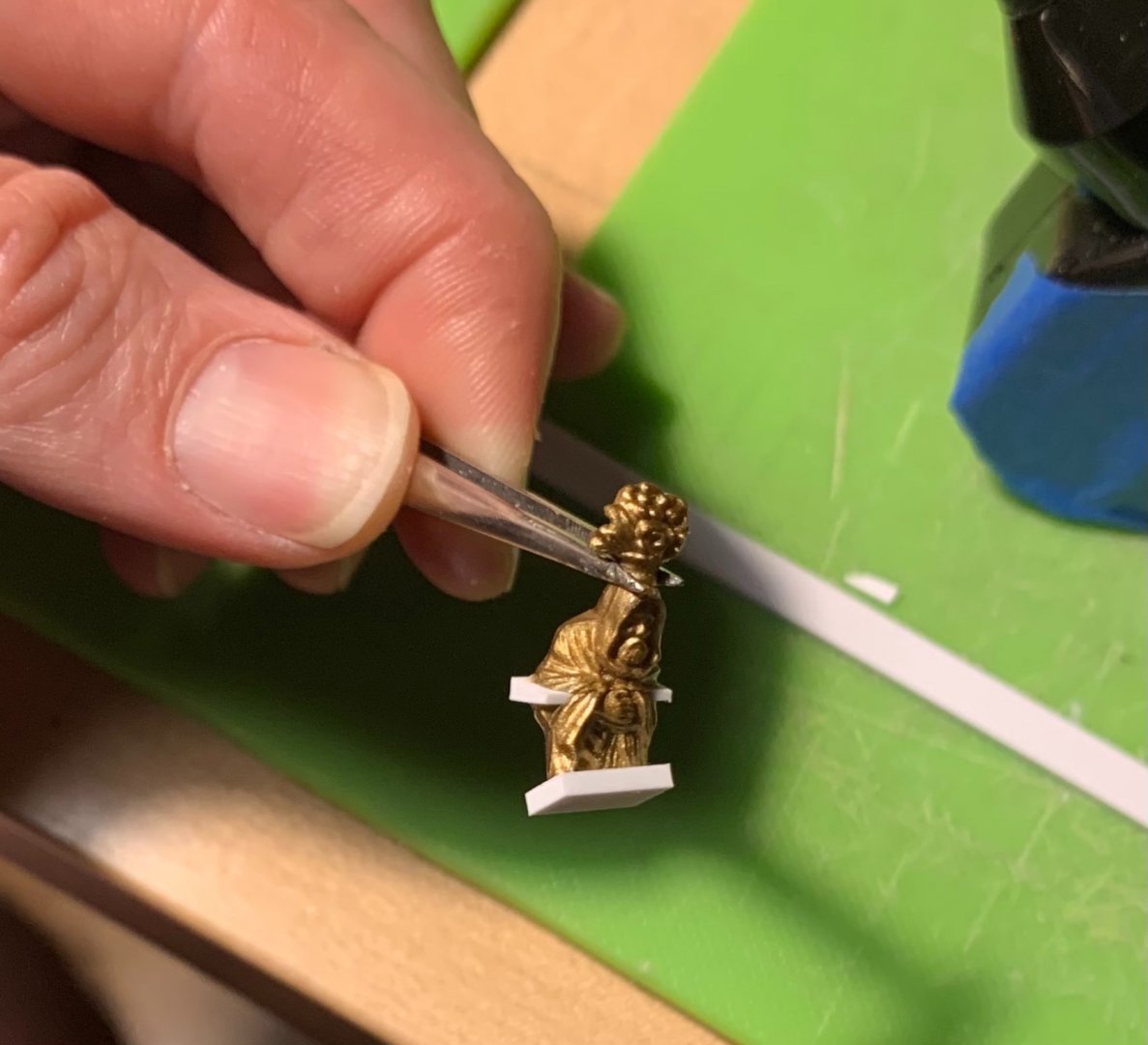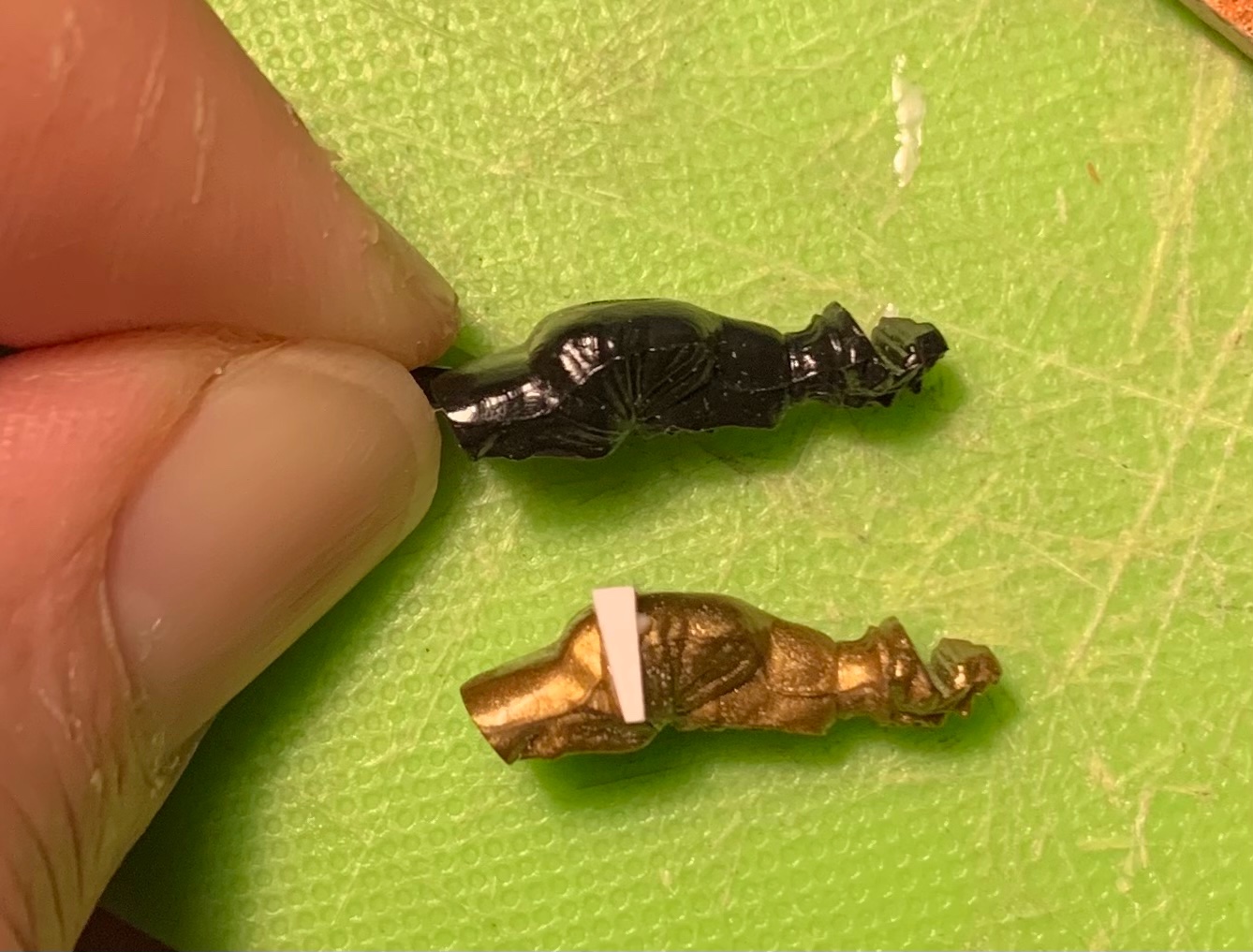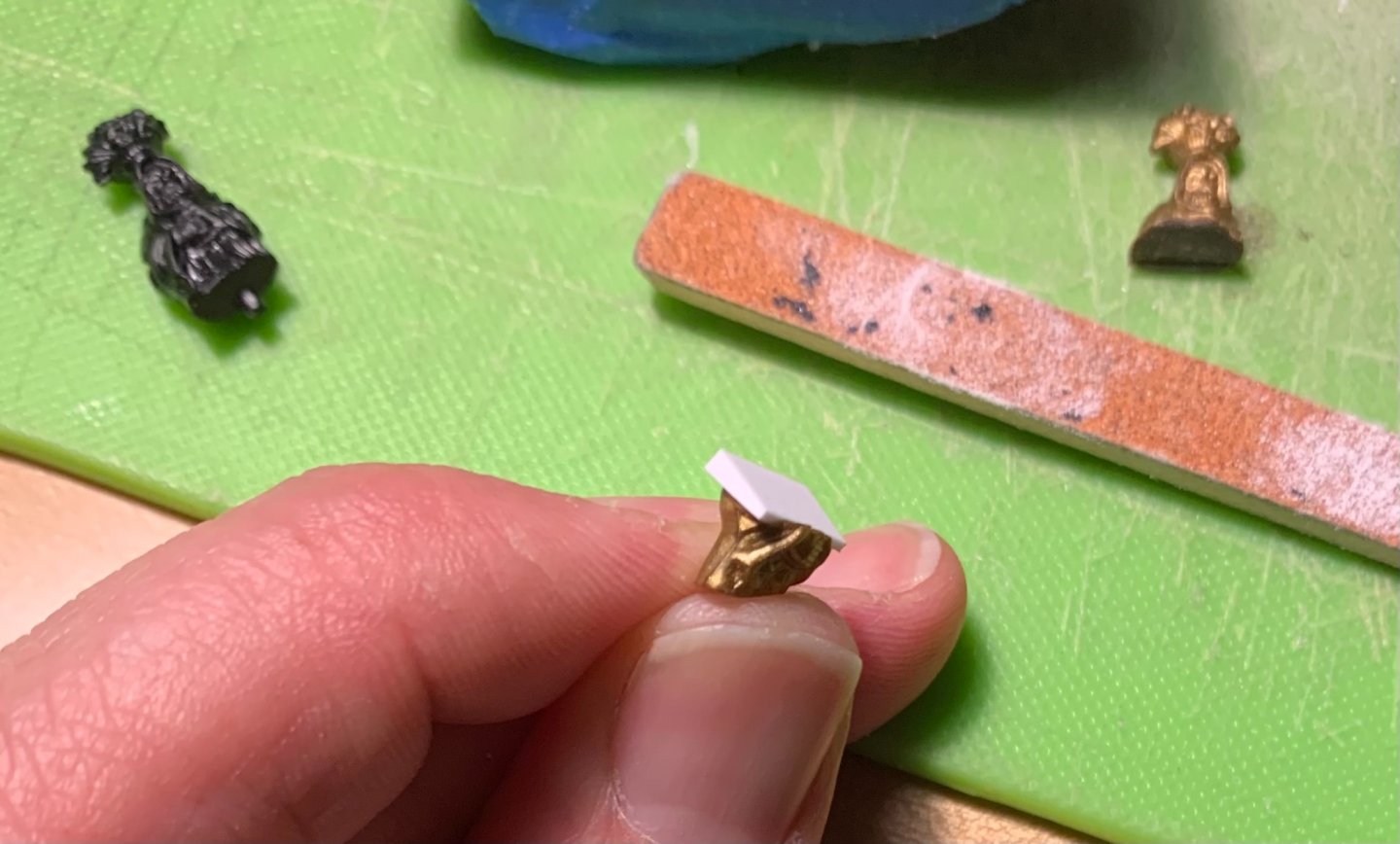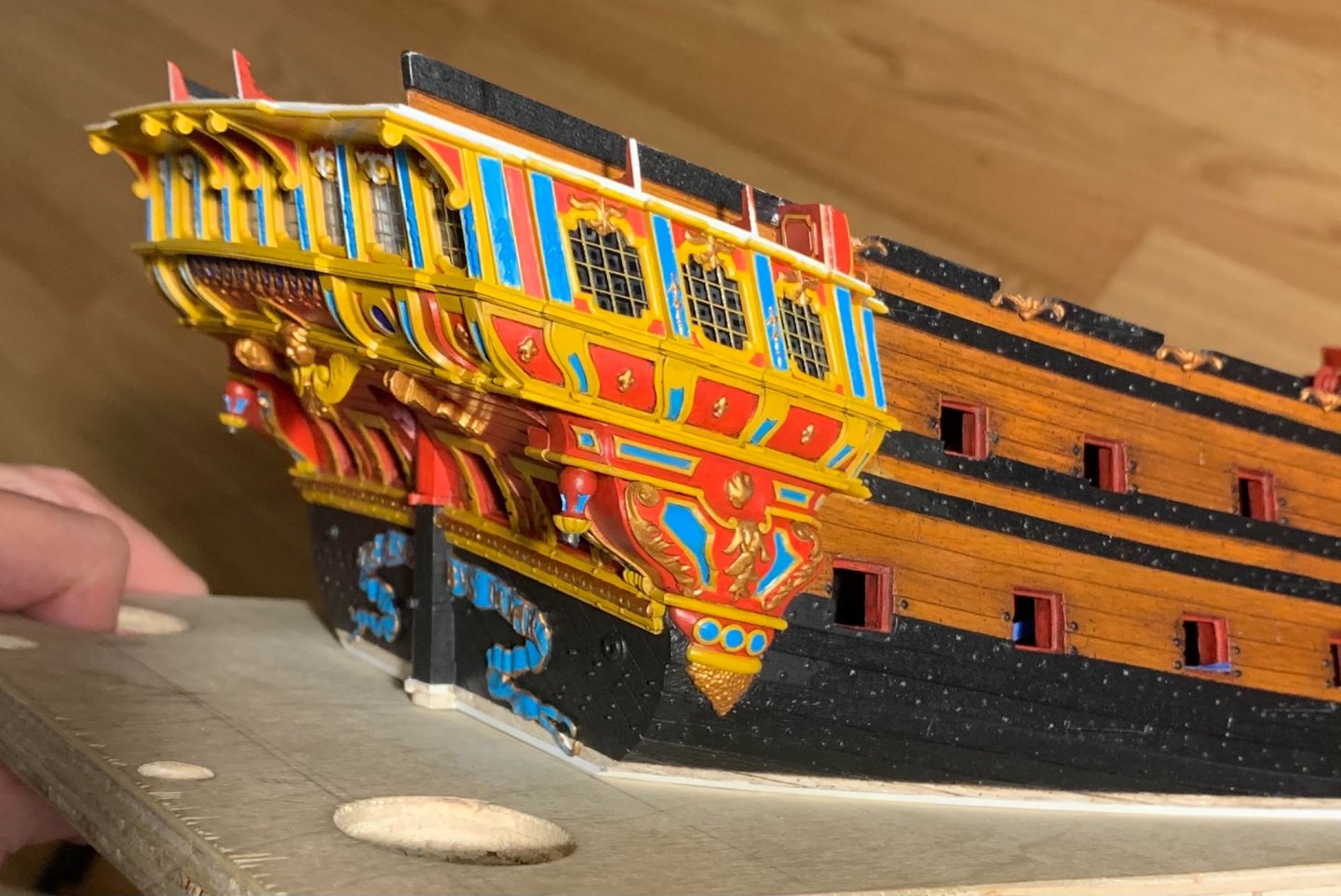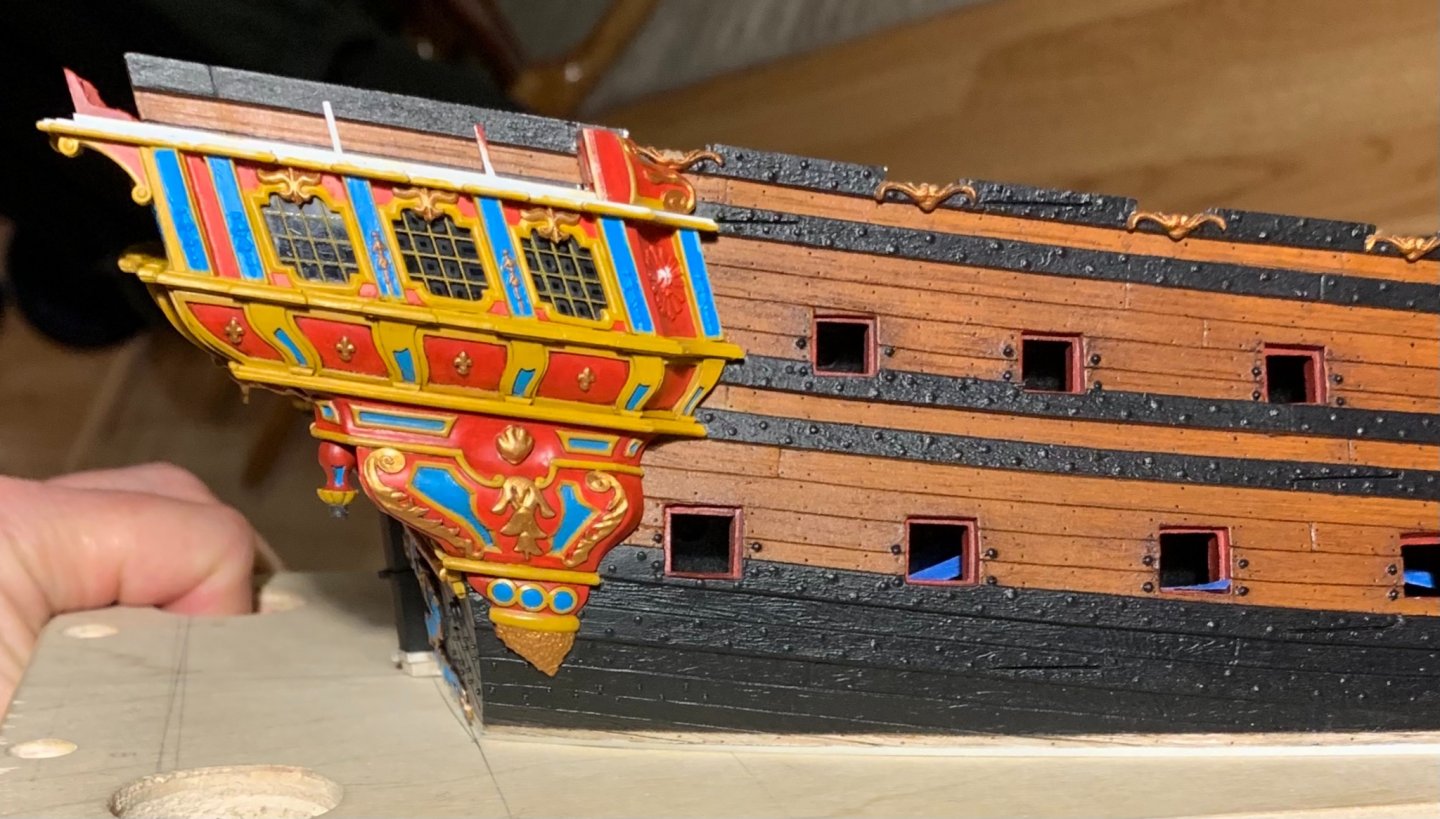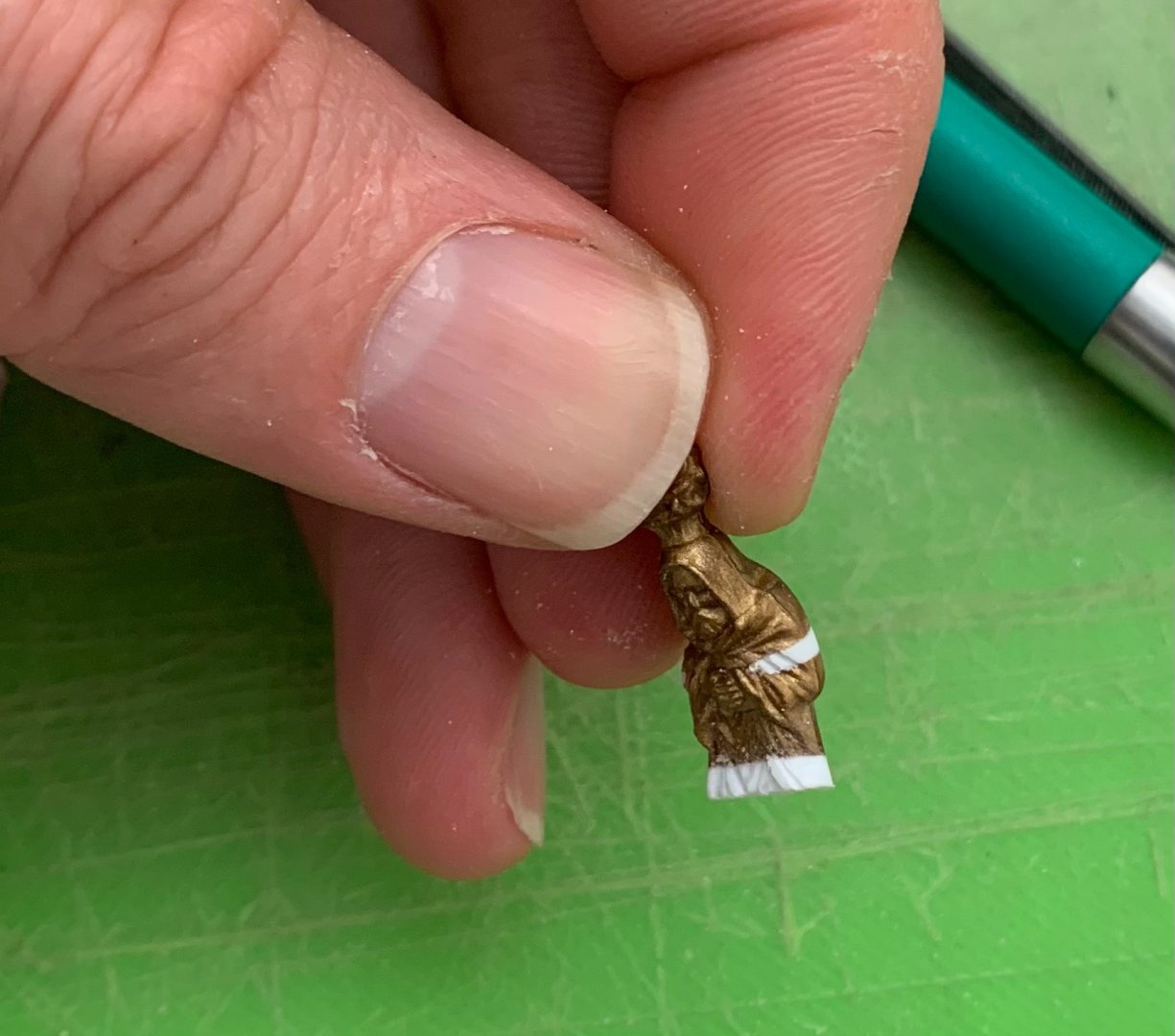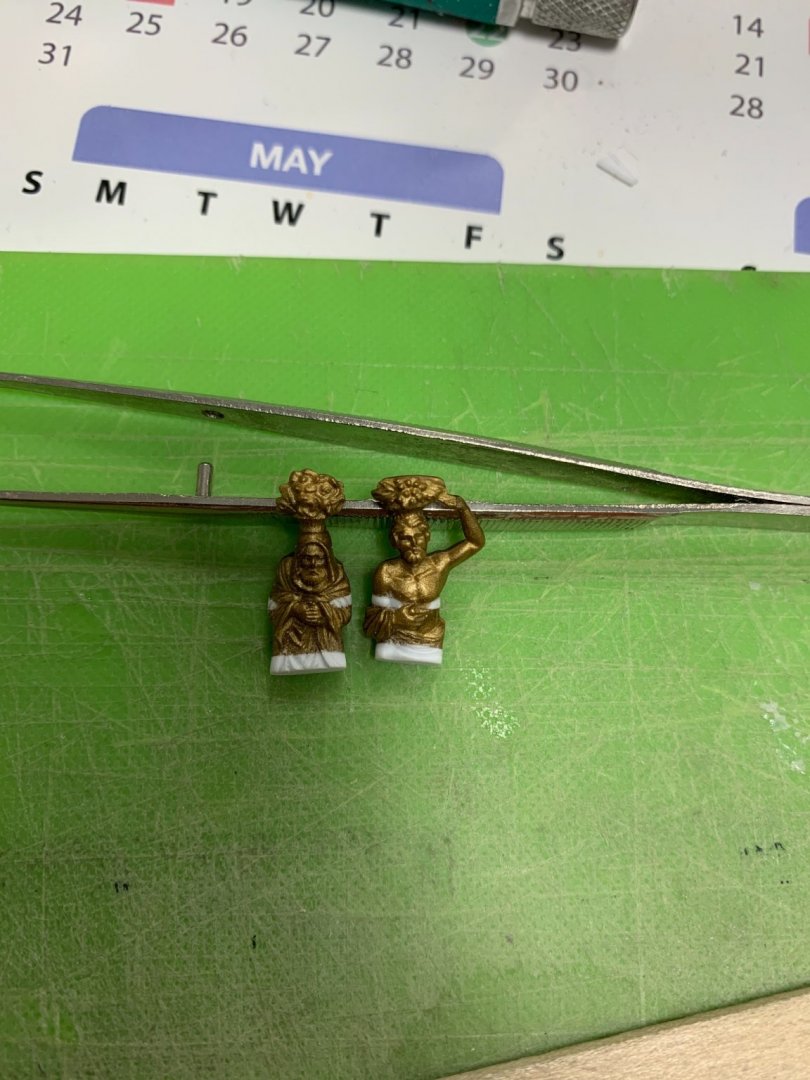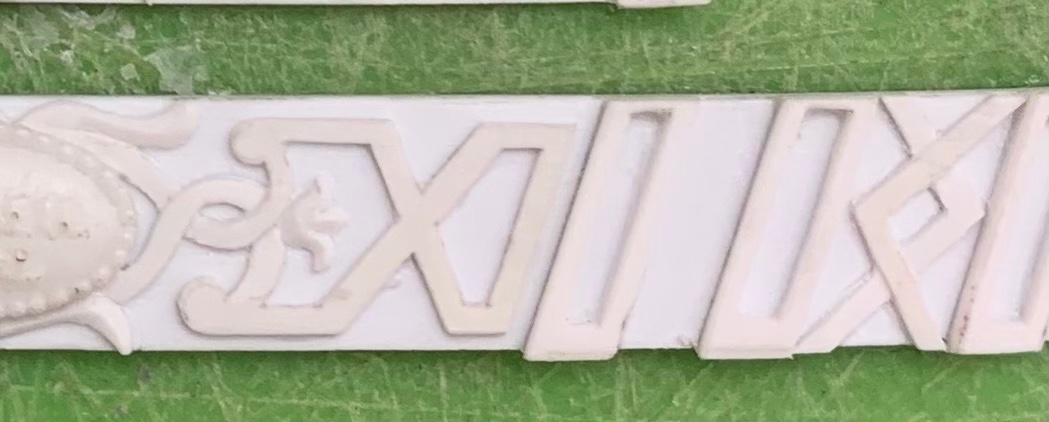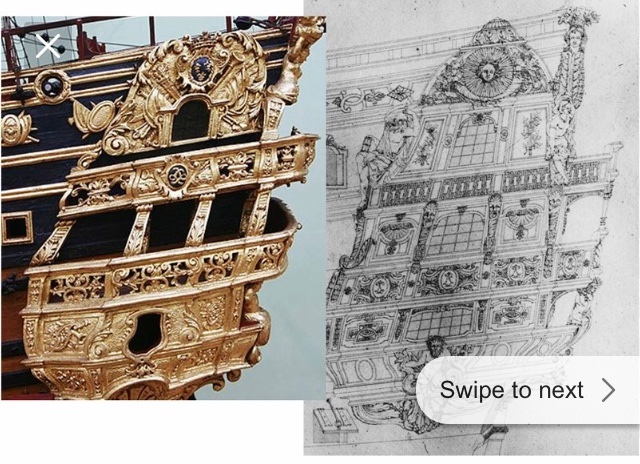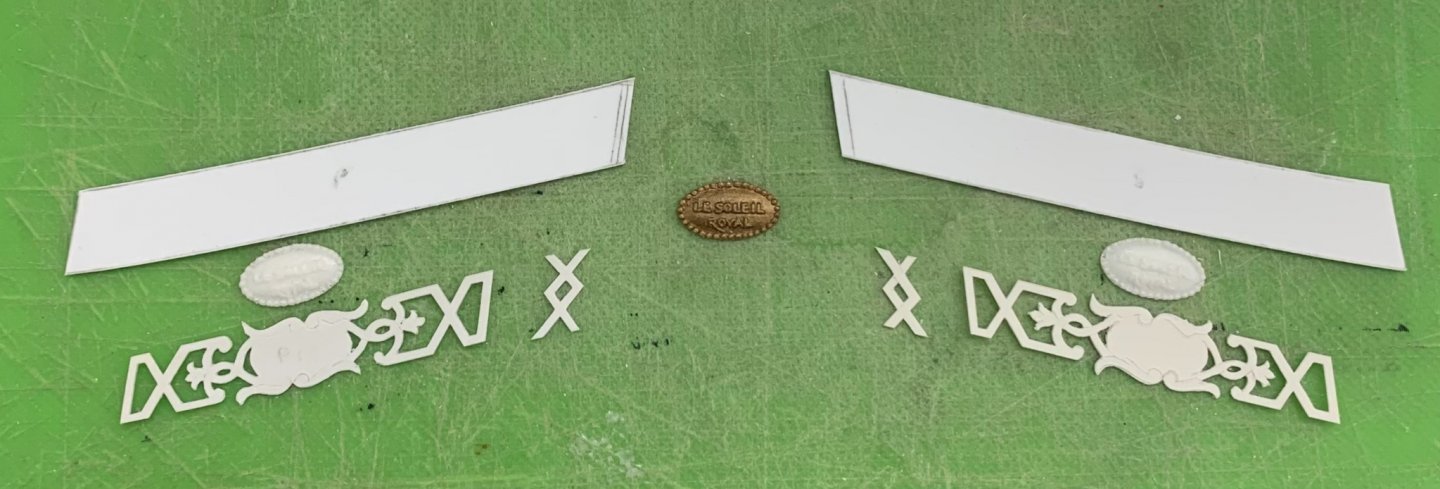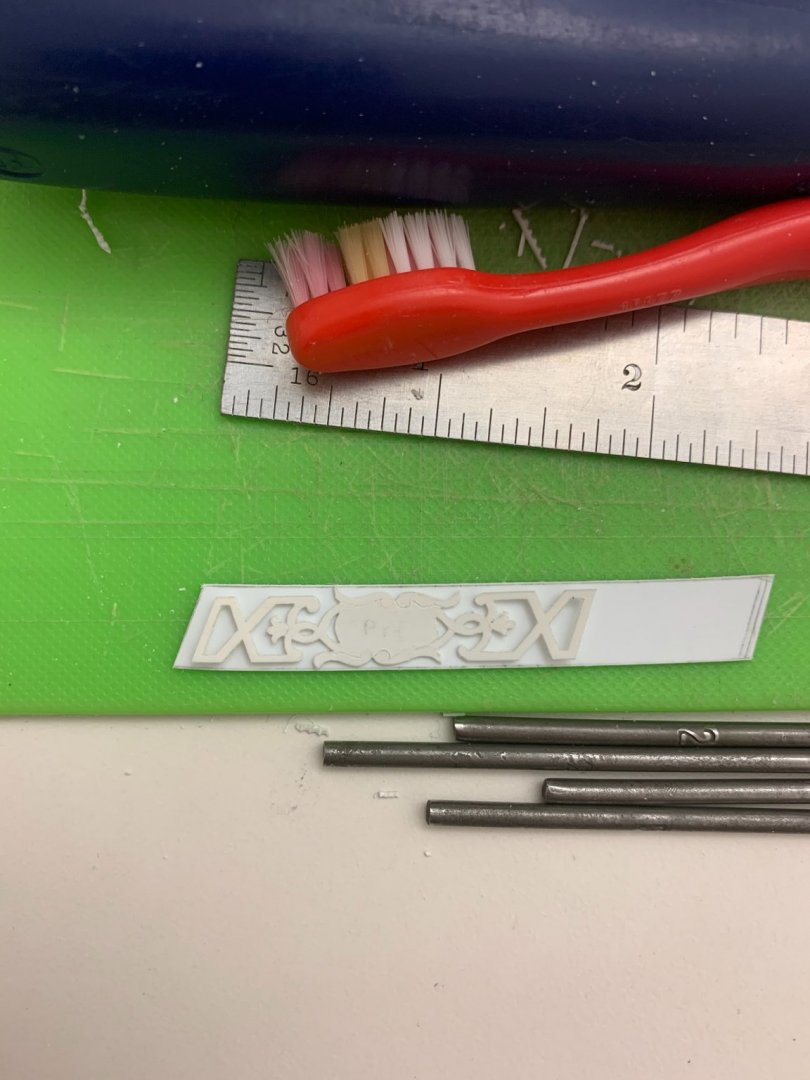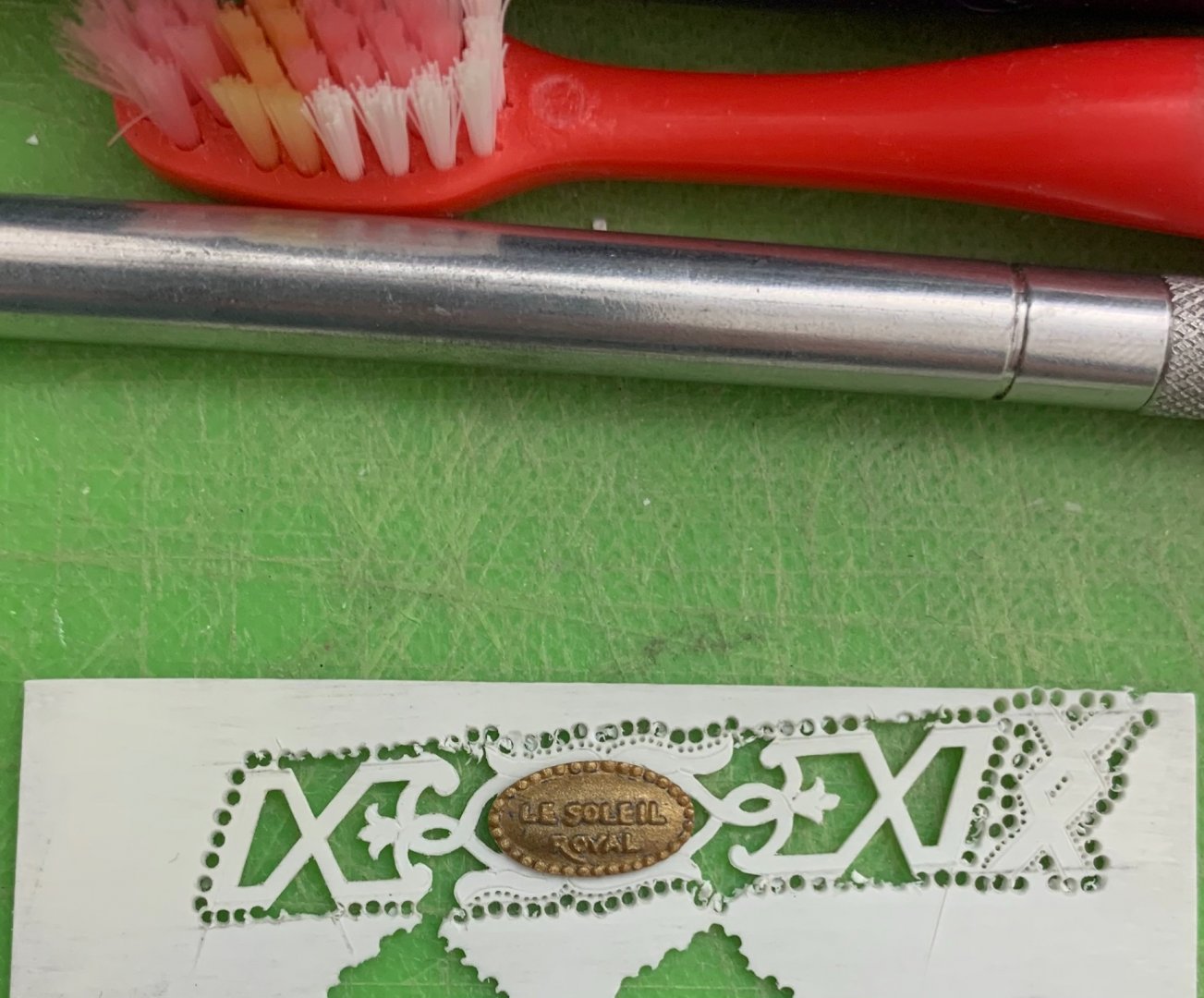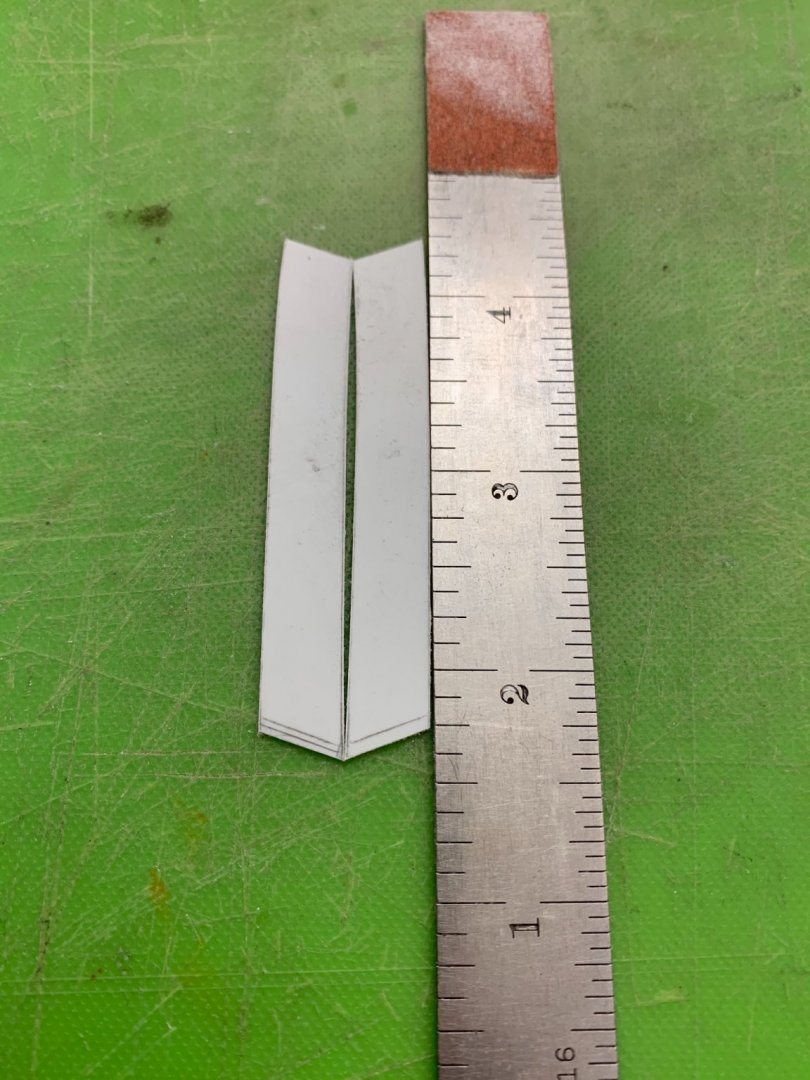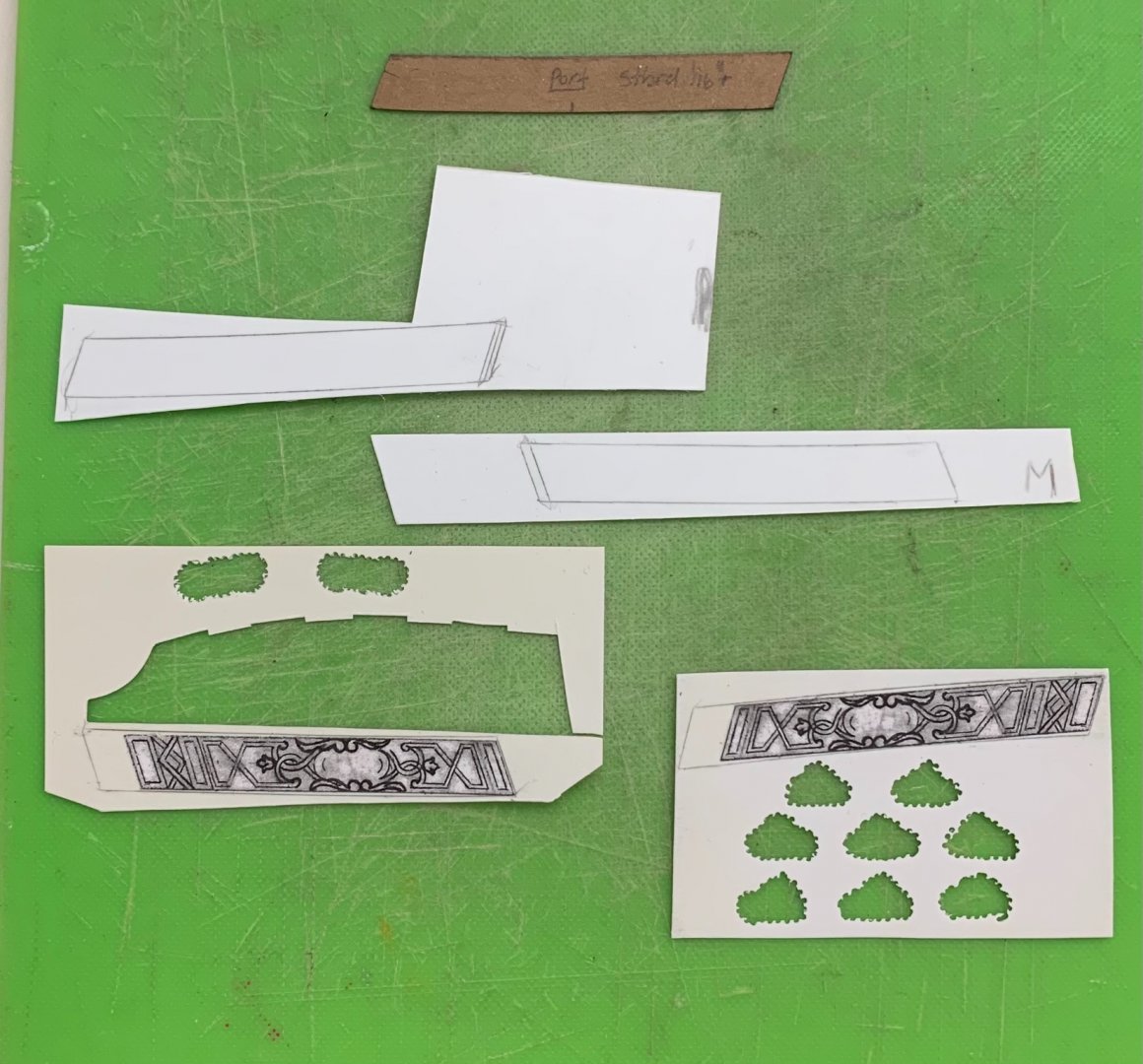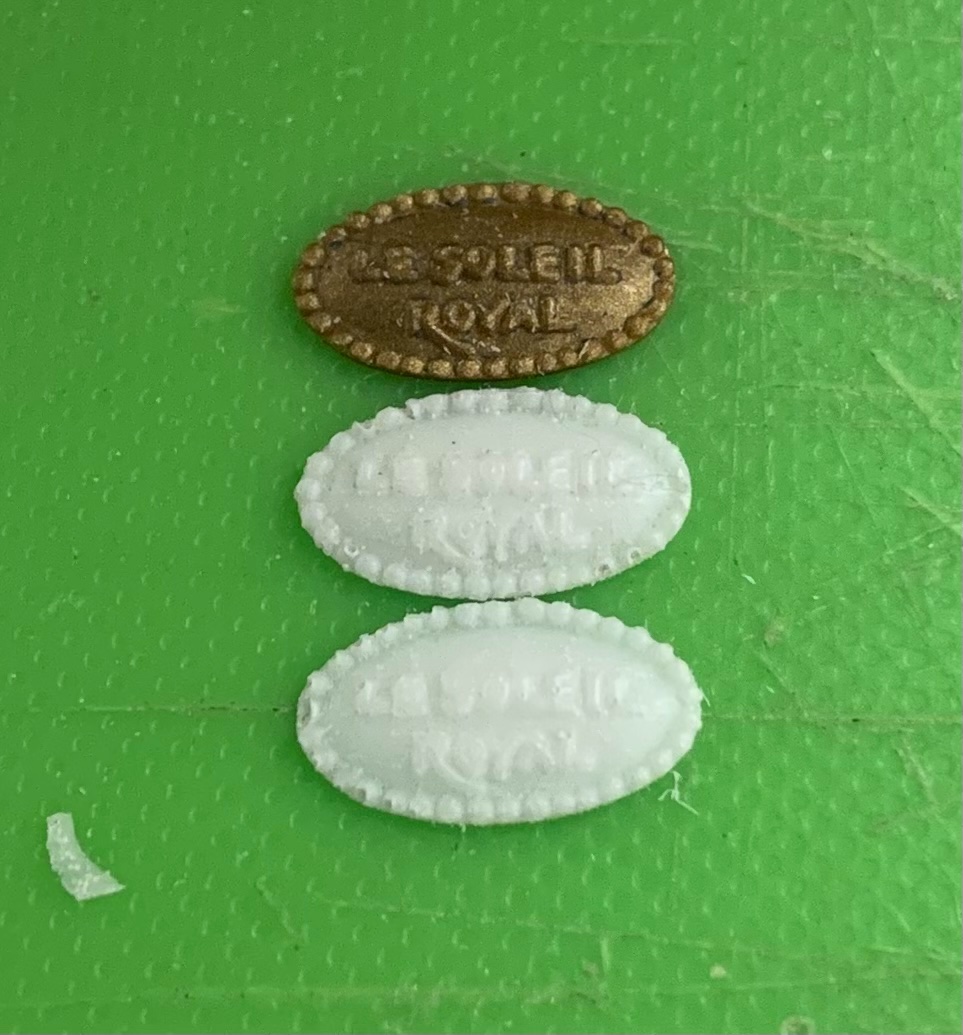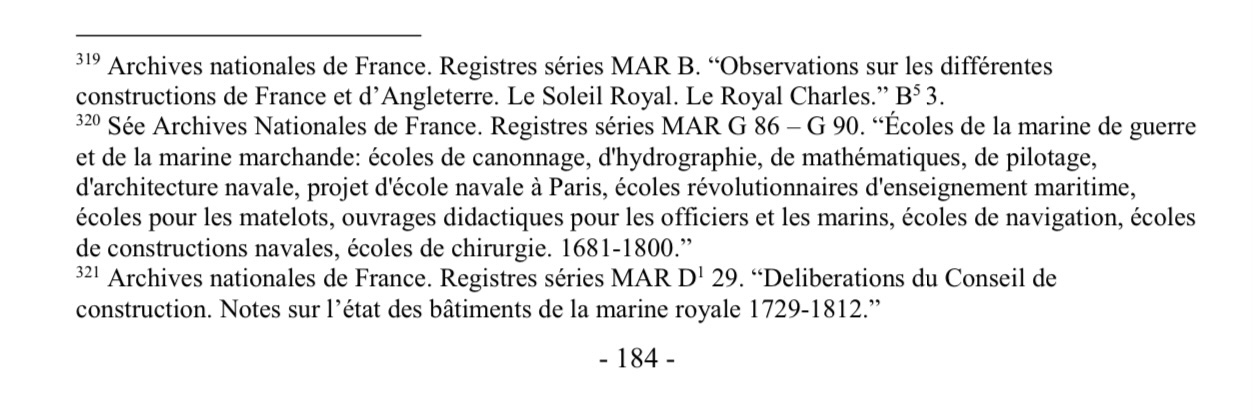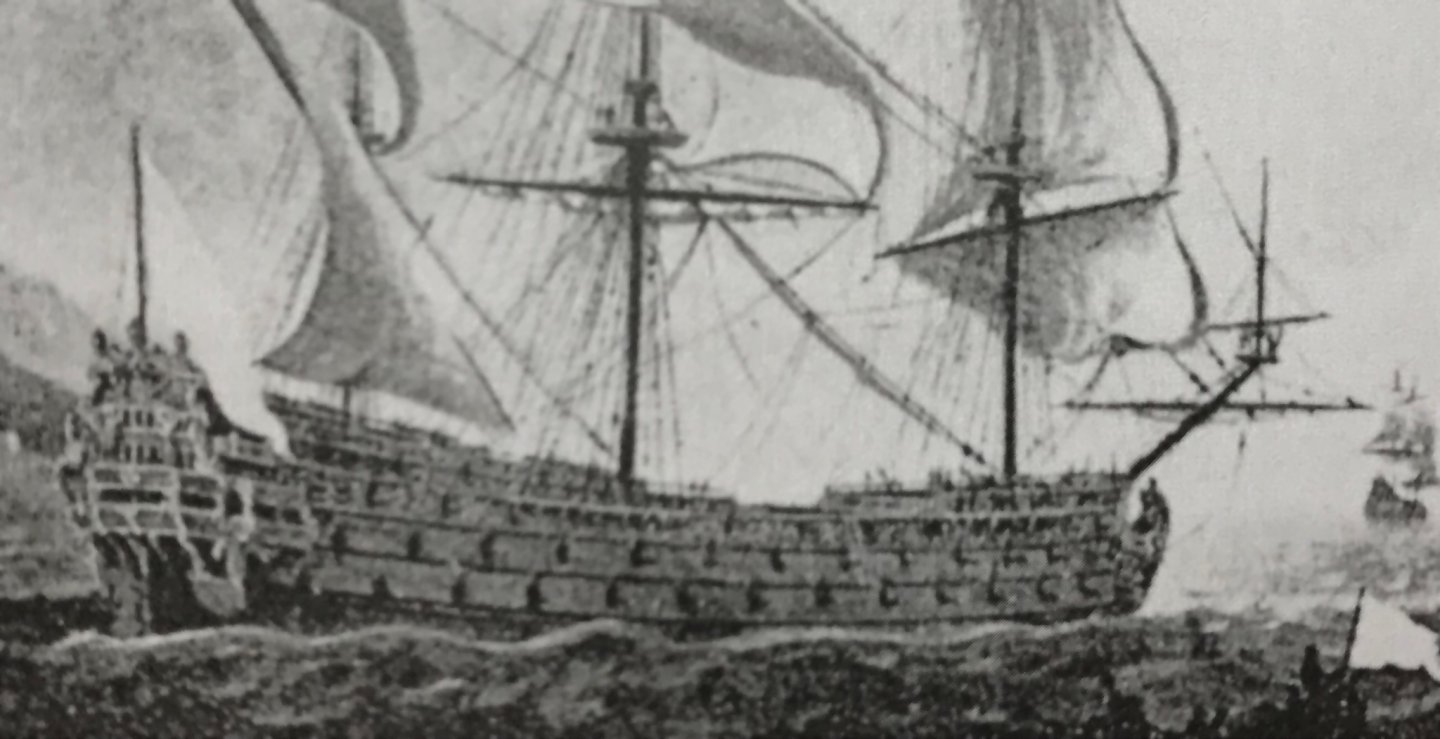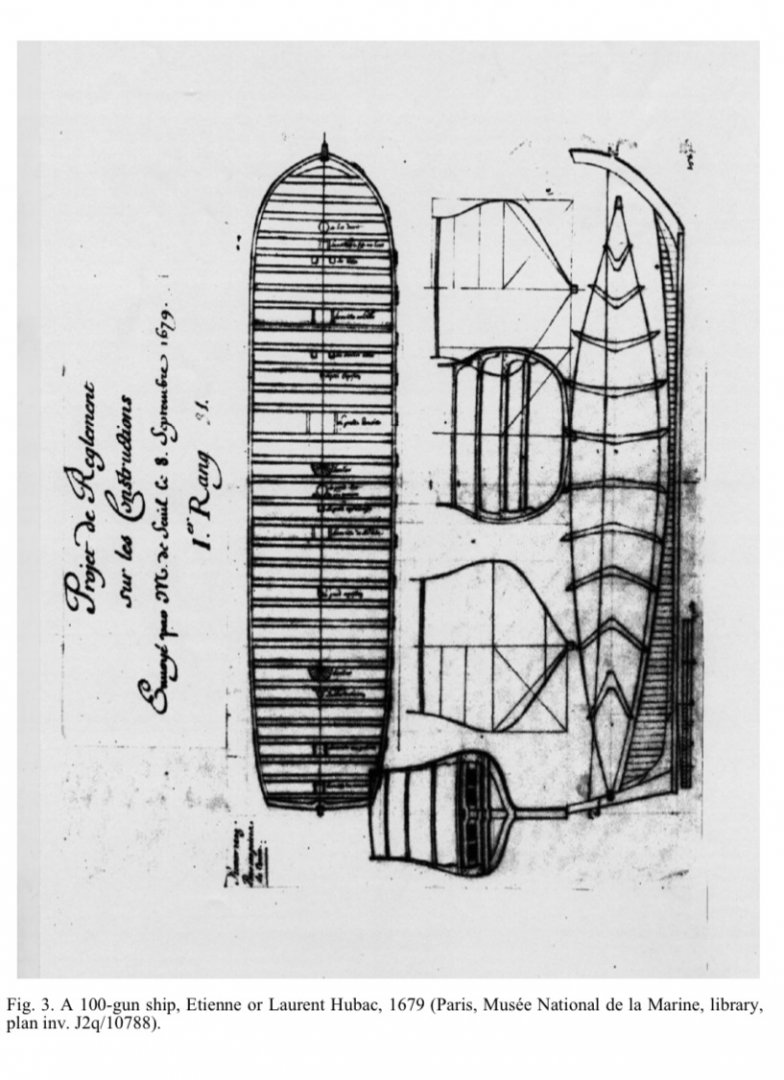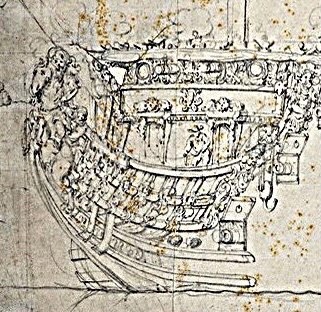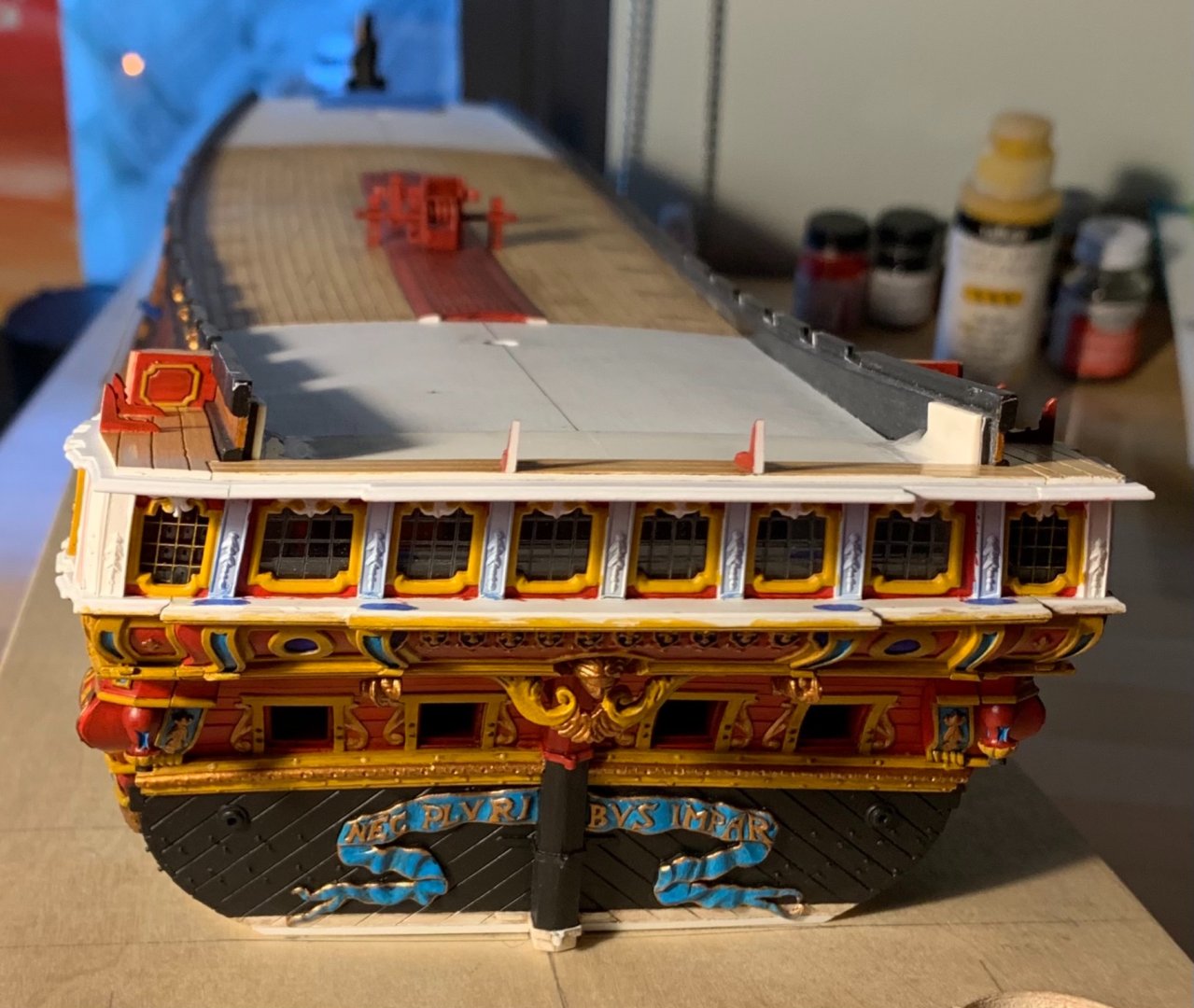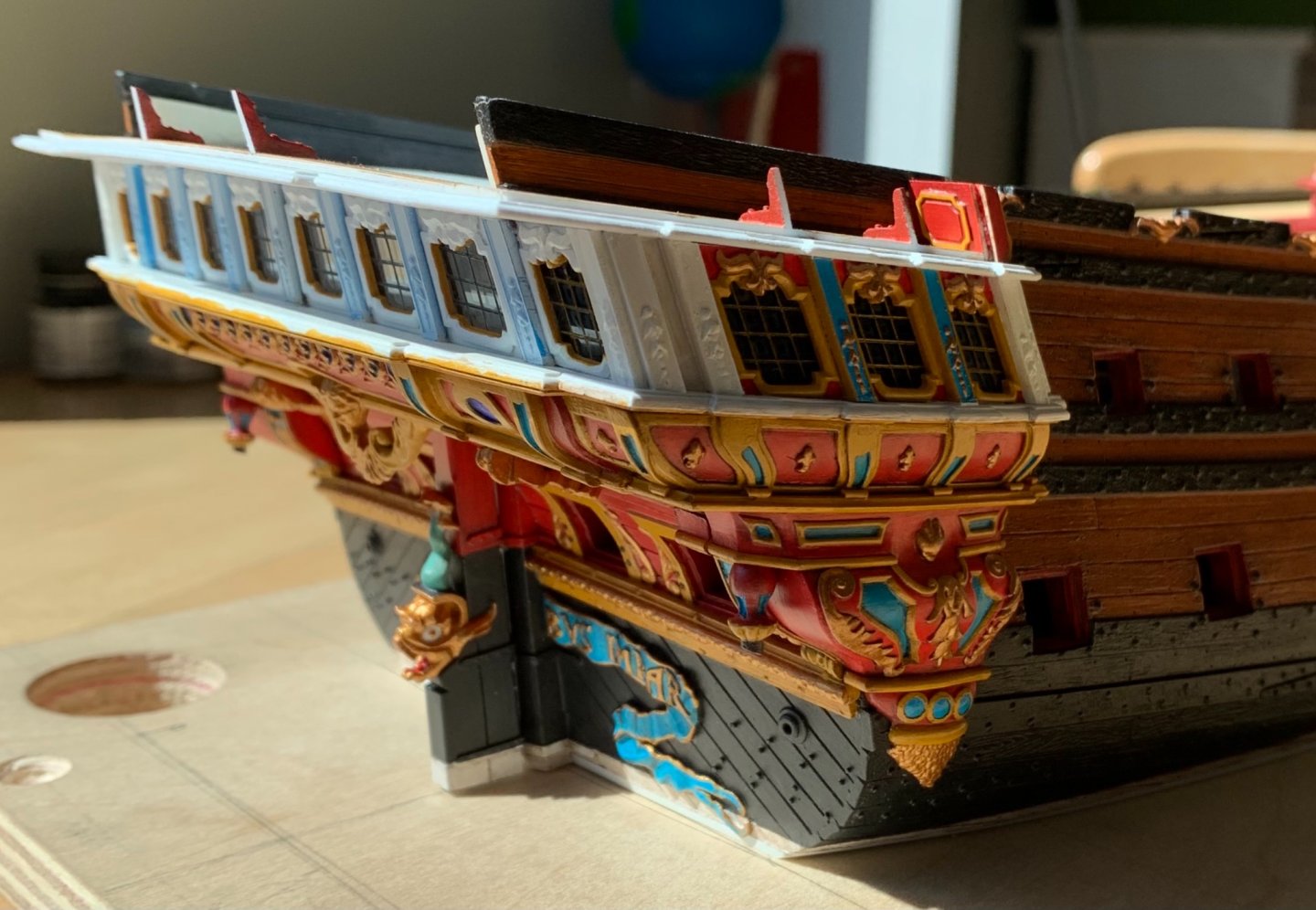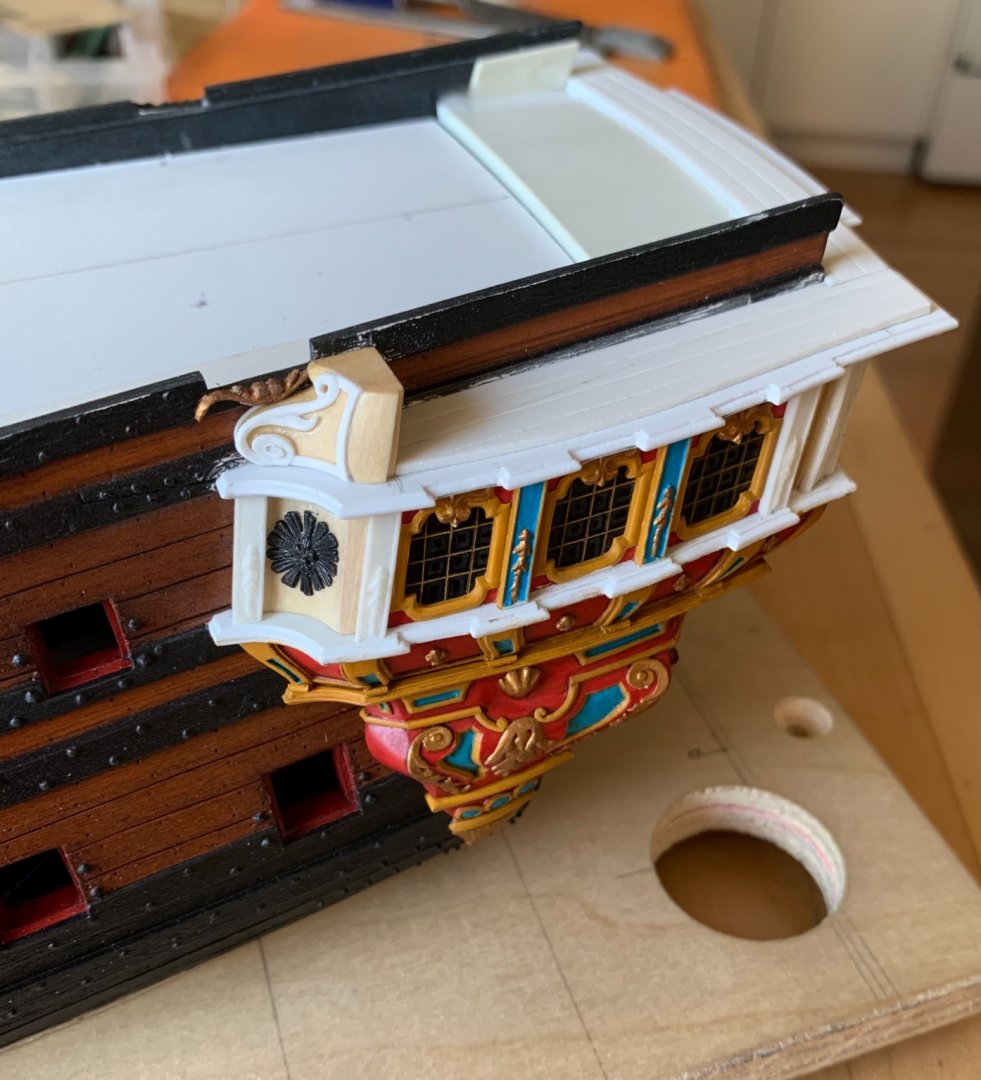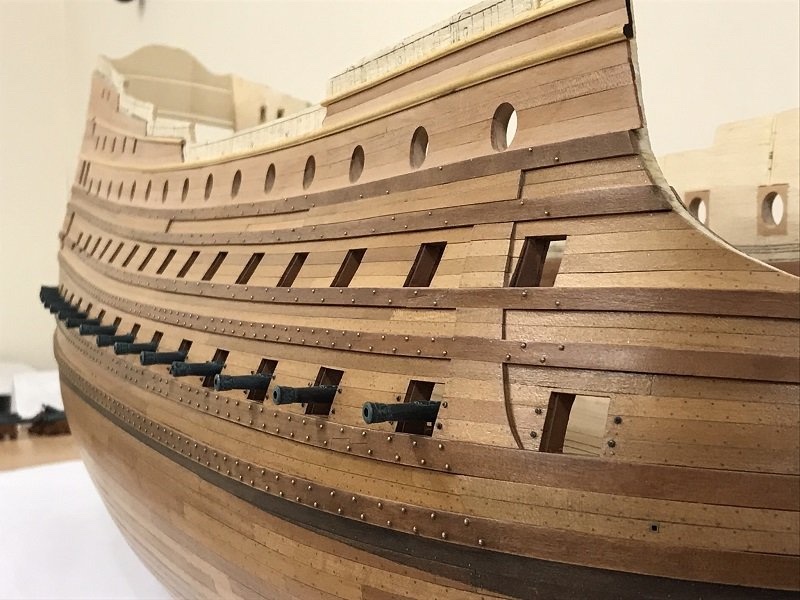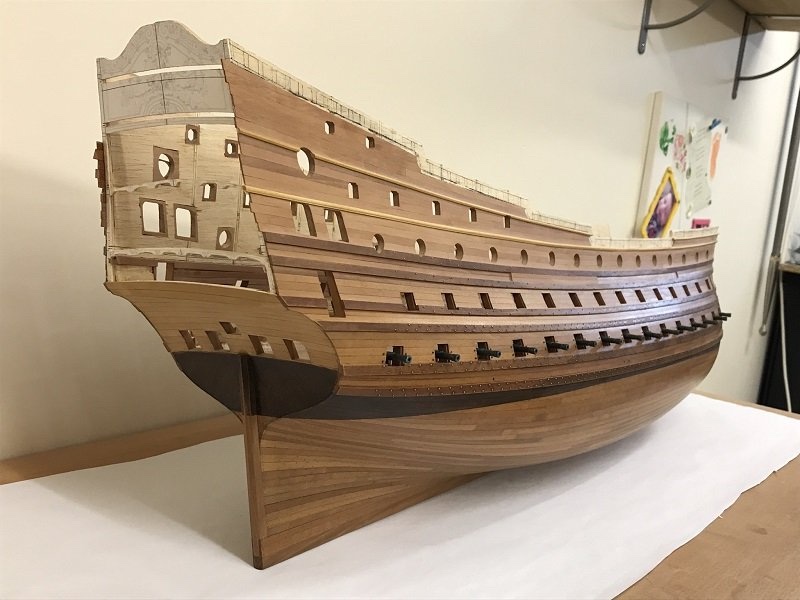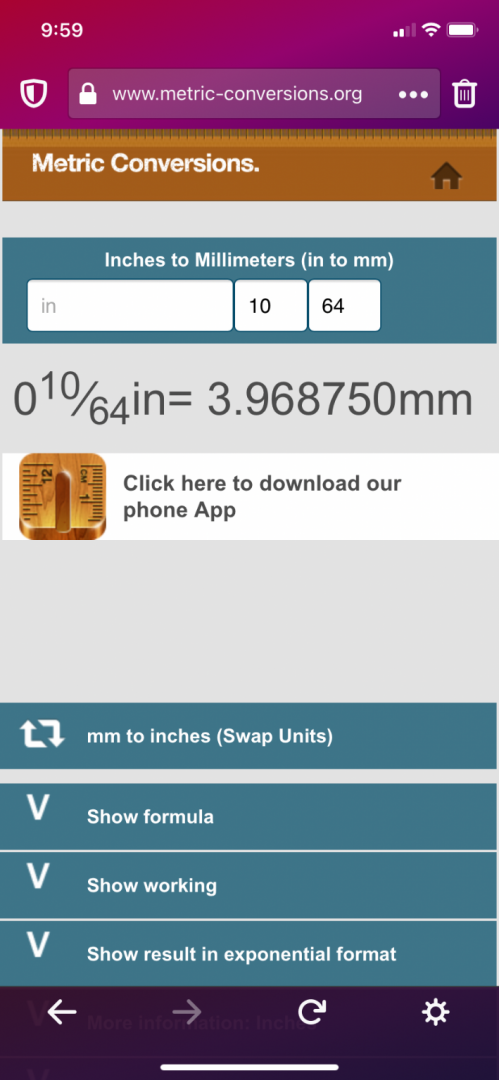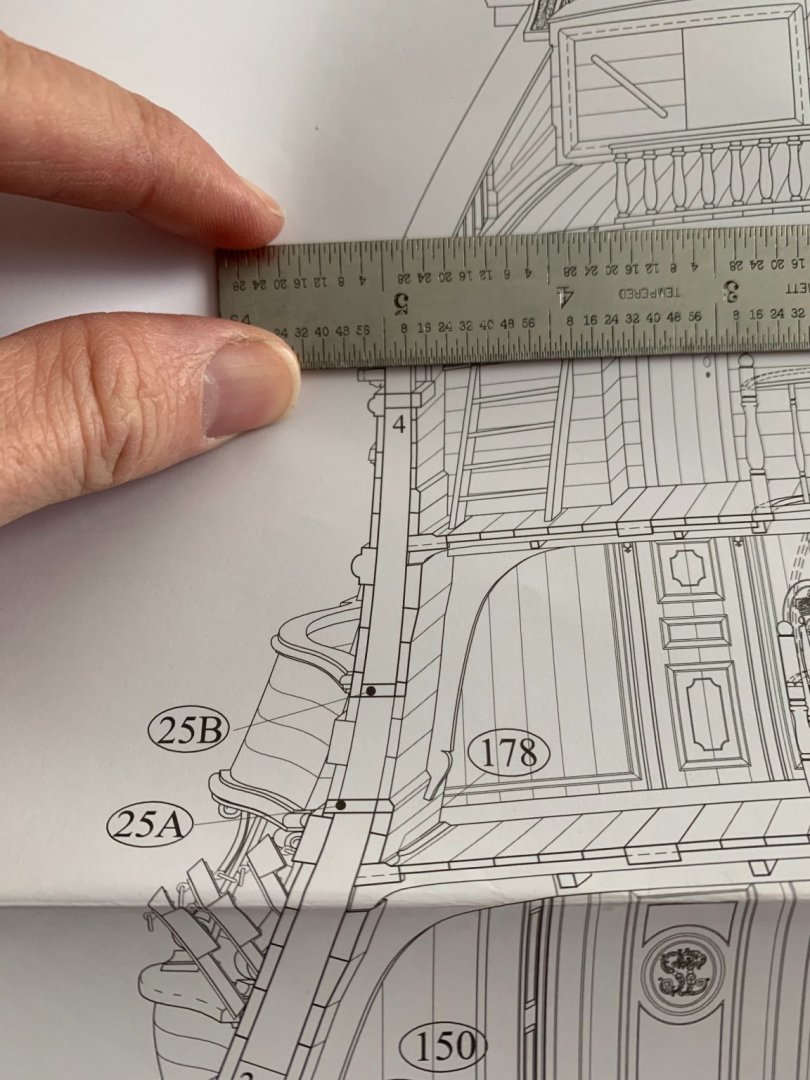-
Posts
3,220 -
Joined
-
Last visited
Content Type
Profiles
Forums
Gallery
Events
Everything posted by Hubac's Historian
-
Also of interest, here, is that the frieze appears to be painted on paper that is applied to the hull - much like Chuck’s Winchelsea.
-

Roter Löwe 1597 by Ondras71
Hubac's Historian replied to Ondras71's topic in - Build logs for subjects built 1501 - 1750
Ondras, you are moving at a fast and furious clip, without any sacrifice in quality. I love all the detail - particularly the scarfing of the stem - NICE! Thank you for bringing to my attention this Barent’s ship replica project. I will look that up - looks fascinating. I’m not sure what to say about the pinrail issue on early 17th century vessels, other than perhaps Vasa is your best guide. When in doubt, personally, I like to fall back on the Van de Veldes for the clarity of their drawings. -
Oh, WOW, this is truly excellent and exciting! I love the work of the card modelers on this site. This is really a very finely worked model. I will be following along. The hull form is very reminiscent of the Dutch-built Vasa - particularly the bluff bow and the bow form below the water line, as it approaches the stem boxing.
-
Lease signing happens this weekend - virtually - so that will be interesting. And yes, while the model overall is quite large, some of the component parts are pretty tiny. Somewhere, Lloyd McCaffery is laughing at me; “you call that small?!”
- 2,623 replies
-
- heller
- soleil royal
-
(and 9 more)
Tagged with:
-
Painting continues. Although the following pics don’t reflect it, all the yellow ocher is done and the walnut ink distress wash has been applied. I’ve begun the gilt work, and am making my way around the gallery. The purpose of these photos is to illustrate the middle balcony tier, supporting corbels. The middle three are stock kit parts. The outer two were scratch-made because even the secondary kit corbels that are more shallow, in depth, still extended beyond my balcony edge; I had made a conscious decision to reduce the depth of my middle balcony because I knew there were limits to how far I could stretch the Four Seasons figures - more on them, in a moment. Among the myriad tiny considerations is the fact that the corbels must align with the tilting angle towards the centerline, as delineated by the pilasters, but they must also account for the secondary angle introduced by the round-up. These were very fiddly to fit. As is my practice, I had masked-off strips on the underside of the balcony to ensure a welded styrene bond. Naturally, this necessitated a certain amount of re-touching to the yellow. The Vallejo paint I’m using is not model-specific, but from their artist’s line, instead. It thins beautifully, but requires numerous passes to achieve good color saturation with a brush. The paint also remains rather soft for a number of weeks after application. For my tastes, these are worthwhile trade-offs for the ease of application and a smooth painted surface. The middle gallery side bulwarks are rounding into form. I made and fit the pilaster pieces, and carved the port side lattice: Not surprisingly these pieces became significantly more stiff when I CA-glued the resin name badges. I will have to heat-form these, before painting and installation, with a hairdryer so that they take the curve of the gallery without introducing stress. As I did for the upper bulwark frieze, I cut hard shoulders and shallow reliefs to suggest an intertwining of the frieze banding: This may seem hard, but it really is not and can be accomplished with nothing more than a #11 blade to cut the shoulders, and a narrow, curved blade to sneak in and cut the reliefs. I was going to add resin scrolls around the name plate, but the flexibility issue, together with the fact that I’d have to relieve these resin scrolls too far into the nameplates, changed my course; I decided, instead, to simply model and define the scroll shapes surrounding the nameplates. I still have yet to add the diamond flower ornaments to the Xs on either side of the nameplates. By far, the most enjoyable phases of this project are those times when I discover an opportunity to re-incorporate stock parts of the kit to my new architecture. Adding the bow extension pieces was the first formidable challenge of this kind. The Four Seasons figures present a similarly challenging attempt at plastic surgery. Tanneron most likely drew inspiration from this later drawing of what I believe is SR1693: As such, there is a projecting lower stern balcony, and the Four Seasons figures have a more upright posture, in supporting the balcony above. The Heller kit reflects this same architecture. In closing-in this lower stern balcony, I have also brought it in, closer to the stern. Consequently, if I want to use the stock figures, I realized I would have to alter their posture and lengthen them. Starting with the outer two male figures of Winter and Autumn, where the overhang is less extreme, this is what I have done: The magic entry for cutting these figures is through the back, just above the elbow, and stopping the cut before breaking through just above the hand. This weird gold plastic is more brittle than the black stuff, and I snapped the first figure, Winter, just above the hand. This was not a problem, though. I then took a piece of 1/16” styrene strip, double-stuck it to the edge of a piece of scrapwood, and then filed a taper ranging from the thickness of the kerf (about a 1/32”) to the full 1/16”, at back. I am always emboldened, in these surgeries, when I have a fall-back set of parts. The difference in posture is slight, but it is just enough to help these side figures conform: I then added a piece of 1/16” styrene to the bottom, so that I can simultaneously increase the height of the figures, as necessary, to meet the underside of the balcony, while simultaneously adjusting the outboard angle. Here is how these two outboard figures took shape: It may seem difficult, but modeling the new plastic to appear like a seamless continuation of the clothed figures really isn’t that hard: The road map of where you need to cut in and continue lines is already there for you. Also, draping clothing is fairly forgiving: Autumn (right) really made out well, in the deal, with some additional bicep definition! It makes me wonder how well my own living body might respond to a little styrene enhancement. I haven’t been to the gym much, lately. That is all well and good for the outer figures. I will still need to add another 1/32” at bottom, and fettle the top joint to the balcony, but I should be able to fit these without much trouble. The middle figures required a little more extreme hunching of their posture, because the balcony above steps out, away from the stern, by about an additional 1/16”. It seemed reasonable to laminate two different thicknesses of styrene strip (1/16”&1/32”), for my torso wedge. Here is how that is taking shape: As can be seen next to the Autumn figure, now the arching of the female backs is notably more pronounced. I will probably need to add some extra plastic to the top edge of the bouquet and model it so that it appears to cope neatly around the bottom moulded edge of the balcony above. All of this may seem like a lot of fiddling about with these figures, but I can assure you that the investment in time is far less than making them from scratch. Besides, Heller did too nice a job of modeling them to believe I could do any better on my own. So, that’s where things stand as of today. In the coming weeks, I will likely have to take a break from Soleil Royal, as my wife and I have made the difficult decision to move, yet again. We barely got to know Brooklyn, and certainly the Pandemic robbed our neighborhood of much of its charm. Nevertheless, an “affordable” 3-bedroom apartment is a unicorn worth chasing. I will periodically still post updates as small work progresses. As always, stay well, and thank you for stopping by.
- 2,623 replies
-
- heller
- soleil royal
-
(and 9 more)
Tagged with:
-
I can appreciate the likelihood that Vasa's launch wasn't stowed on deck because the waist of the ship is not fitted with skids that would have facilitated the lowering of the boat along the ship's side. What puzzles me is what the crew would have done to keep the launch free of water, if it were towed behind the ship, as is often seen in battle portraits; if there's any kind of weather happening, that little boat will fill with water, pretty quickly - especially if rough and pitching seas threatened to capsize this little craft. I wonder how 17th C. crews managed this.
-
As you should be - the canopy looks really good! Is this the temporary dust shelter that you built to house the model during the masting/rigging stage. I have to say, this is a very good solution to the problem. At some point my built will grow beyond the plywood build box that I made to house it during construction. Until my son turned out to be extremely allergic, we briefly had a cat, whom I imagined would eventually take up residence on top of the build box, as it is at a nice perching height. The cat now lives with my sister, but dust is always a problem. I like that the corrugated plastic panels are rigid enough to drape a sheet over the whole thing when you aren’t working on the model. Every time I see this model, I am tempted to add it to my stash. It is such an elegant and beautiful vessel.
- 222 replies
-
- reale de france
- heller
-
(and 1 more)
Tagged with:
-
Agreed on a job well done! Sometimes you have to pick your battles!
- 222 replies
-
- reale de france
- heller
-
(and 1 more)
Tagged with:
-
This is going to be a lovely little boat, and I will gladly follow along.
- 433 replies
-
- open boat
- small boat
-
(and 1 more)
Tagged with:
-
Hey Vic! The old adage about loving your work making it feel less like work, definitely applies, here. I am fortunate to have significant chunks of time to home-in and focus, but even incremental progress in the smaller 15-30 minute windows adds up. The truth is, though, that it is hard to sit and work at something like those lattices for much longer than an hour, without a break. I’m driven forward by the gradual materialization of something that I could see quite clearly in my imagination.
- 2,623 replies
-
- heller
- soleil royal
-
(and 9 more)
Tagged with:
-
If it were solid timber, John, they could conceivably laminate several pieces of spruce, for example, as would be done for the figurehead. That assembly could then key into the wales, just as I made for the model, and then be through-bolted into the hull framing, so that the quarter gallery structure, itself, weren’t carrying the weight. This approach would allow complete freedom of form. Maybe though, as you suggest John, it was all light framing and thin plank. I have no idea, really. Painting of the stern continues at a snail’s pace. It is all crisply done, though, so the time is well spent. I’ve been making the port and starboard gallery bulwark lattices. My technique has improved since the making of the trailboard, so I am no longer breaking these delicate lattice pieces as I go. Rather than mostly trying to file these delicate pieces into shape - which fatigues the plastic in the narrowest sections of the design - I have learned to pare to my lines with a razor sharpe no. 11 blade. I’ve also learned my lesson about how to scribe part blanks for the bulwarks around an angled, curving surface: The trick to this sort of multi-level relief is to use styrene sheet of varying thickness. The bulwark uprights are cut from .030 sheet, while the lattice relief is .020. From the stock middle balcony rail, I extracted the ship name plate I will have to offer the bulwark blank up to its place on the QG, so that I can mark out the exact pilaster locations from the level below. Then, I can glue the lattice to the bulwark, and secure the pilasters and the diamond lattice detail. The pilasters will be cut from .030 sheet, and will sit just a little proud of the lattice, thus creating the desired depth effect. I made rubber moulds of the nameplate, so that I could duplicate it and have the name on both the stern and quarters. There is a significant investment in time just to get to this: I will also surface mount smaller resin scroll ornaments around the name plates, as well as diamond flower ornaments to the lattice. In other musings, I have been in contact with Mr. Portanier. He has been helpful in sharing several of his sources. Among those were several key articles from the French nautical journal Neptunia, published by Les Amis Des Musees de la Marine. In a separate posting, site members directed me to the following resources for finding back issues: https://www.aamm.fr/neptunia/recherche_articles The above links to an index of every issue and article that Neptunia has ever published. The index spans 75 years and over 300 issues. I am indebted to all of you who have been so helpful to me and this project. A listing of issues in print that are available for sale can be found here: https://boutique.aamm.fr/neptunia In going through the index, I discovered around 25 articles that are specific to my time period and/or subject. A number of additional articles, based on the abstract description, seem like they may he helpful. For 5 euros, per older issue, that seems well worth the gamble. A number of issues that I would really like to have, like a multi-part series by Bernard Frolich on the development of his model of L’Ambiteaux, are currently unavailable in print. Courtesy of Mr. Francis Graviou, I can contact the site administrator to see about obtaining those issues digitally, perhaps: contact@aamm.fr I think, perhaps, the greatest value of a substantial piece of research, like Mr. Portanier’s dissertation, is where else it may lead you to keep searching for answers. His cited works are extensive, and I can assure you that there is often great value in the reading of footnotes. I may never find the portrait of my gilded ghost ship: But I do, now, know where to look for the following: Now, I merely need to figure out how to contact the national archives and obtain a copy of these documents. I am not expecting the expansive detail that Hyatt provides in his description of the RL, but it would be reasonable to expect to glean some key information about Soleil Royal’s original structure and appearance. That could go a long way toward fleshing out a portrait of her appearance between the years 1670 and 1685. I also stumbled across this: From a time when the lead architects like Laurent Hubac were being continually nudged by Colbert’s administration to conform to a codified prescription of dimensions, this I would say, is a pretty good insight into the design modality of, perhaps, the most intractable of the arsenal shipwrights. Laurent Hubac liked a broad-beamed ship, and that is exactly what this drawing indicates. Also, if one makes a very close examination of the starboard side of this drawing, they will discover a series of regularly spaced hash marks. This drawing is of the broadest, lower main battery deck. I believe that these hash marks represent port piercings. There are 15 broadside hashmarks, with what appears to be one more “hunting” port hash mark, near the hawse entry. In other words, something very like this closeup of La Reine’s port bow: photo, courtesy of Chapman There were only two Hubac-built ships, that I know off, that were pierced for 16; La Reine and Soleil Royal. Very interesting, indeed! As always, stay well, and more is to follow...
- 2,623 replies
-
- heller
- soleil royal
-
(and 9 more)
Tagged with:
-
Marc and John, thank you so much for your kind words. And John, I am equally enjoying the work that you are doing with this fabulous Heller kit. Your figurehead has me considering how I will color the other robed figures that inhabit my upper bulwarks. It has been a bit of a hectic week, as I consider moving my family, yet again, in the never-ending quest for a reasonable three-bedroom apartment in NYC. Slowly, I have been assembling the QG open walk and painting the stern. It is fiendishly difficult to get into the recesses of this stern window plate, and I really wish I had painted it off of the model. Slowly, though, we are getting there: I’ve masked with blue tape, the footprints of the Four Seasons figures. I also decided to extract as much recyclable detail from the two extra stern plates that members of this community have so generously donated. On the forward end of the open walk, I thought that block could do with a little finishing, so I extracted the paneling detail from that same corresponding area on the stern-plate, turned it sideways, and now that looks a little nicer. The bombastic form of this block, which I may or may not be interpreting correctly, is very curious to me: I wonder how such a thing would actually have been made on the real ship. would they have sheathed a light framework with thin deal planks, or would they have shaped a solid balk of lightweight timber, much like I have for the model? The other interesting discovery, this past week, was Ronald Portanier’s dissertation on the evolution of French marine sculpture throughout the Ancien Regime. He has a number of interesting insights into decorative styles, color and the use of Trompe L’oeil. It is quite lengthy, but well worth the look. There are a few gems in the Appendices, also, including a super detailed port quarter view of the Monarque/RL’s stern - something I was just asking Chapman about, recently. There is also a fascinating unfinished rough sketch for the stern of an early First Marine, first-rate ship. If that weren’t enough, there are also several insightful LeBrun portraits that give a good sense for the colors that might be used to accentuate the ship’s carved figures. Check the link below for a look-see: https://spectrum.library.concordia.ca/984742/1/Portanier_PhD_S2019.pdf As a side note, the BSI debonder does an excellent job of sloughing away the finished surface of acetate. I think I will just live with the blemish. It is small.
- 2,623 replies
-
- heller
- soleil royal
-
(and 9 more)
Tagged with:
-
I really like those gallery details, Kirill. The masthead crosses are also interesting details; they are emblematic of the religious devotion of the Spanish empire as well as the sailorly superstitious belief in talismans to ward off evil outcomes. Where else to put a cross, but as close to God as possible, at the top of the mast heads. Excellent VdV grisaille drawings, as well. I’ve added these to my image files. These are particularly fine, and as close to photographic in the rendering of details.
- 228 replies
-
- spanish galleon
- lee
-
(and 1 more)
Tagged with:
-
I am sorry, Christian, that you seem to take this commentary as a personal attack. I hope you will understand that that is far from the spirit that is intended. I only offer observations and criticism when I believe the builder is capable of doing something with that information. I followed your build, in the first place, because I believe you can pull it off, so to speak. You are making a nice job of it, so far. The objective of my commentary is solely to help you avoid creating a circumstance, early, that is difficult or impossible to remedy later. Of course, I respect your wish to work privately and wish you the best of luck!
-
Forgive me, please, but I have to back Allan on this one. I am not accustomed to metric scale. Fortunately, though, we have the technology. My copy of the monograph is 1/48 - big enough to sail away in: The timberheads before the break between the quarter and poop sheer steps measure 10/64”, imperial. So, at 1/48”, the timberheads (inside the planking) would measure a hair under 4MM. At your scale of 1/72, this dimension should be significantly smaller, still. I agree with Allan that now is the time to thin these, before finally glueing them in. Personally, I would leave them just a little heavy to allow for fairing, after they are glued-in.
About us
Modelshipworld - Advancing Ship Modeling through Research
SSL Secured
Your security is important for us so this Website is SSL-Secured
NRG Mailing Address
Nautical Research Guild
237 South Lincoln Street
Westmont IL, 60559-1917
Model Ship World ® and the MSW logo are Registered Trademarks, and belong to the Nautical Research Guild (United States Patent and Trademark Office: No. 6,929,264 & No. 6,929,274, registered Dec. 20, 2022)
Helpful Links
About the NRG
If you enjoy building ship models that are historically accurate as well as beautiful, then The Nautical Research Guild (NRG) is just right for you.
The Guild is a non-profit educational organization whose mission is to “Advance Ship Modeling Through Research”. We provide support to our members in their efforts to raise the quality of their model ships.
The Nautical Research Guild has published our world-renowned quarterly magazine, The Nautical Research Journal, since 1955. The pages of the Journal are full of articles by accomplished ship modelers who show you how they create those exquisite details on their models, and by maritime historians who show you the correct details to build. The Journal is available in both print and digital editions. Go to the NRG web site (www.thenrg.org) to download a complimentary digital copy of the Journal. The NRG also publishes plan sets, books and compilations of back issues of the Journal and the former Ships in Scale and Model Ship Builder magazines.



